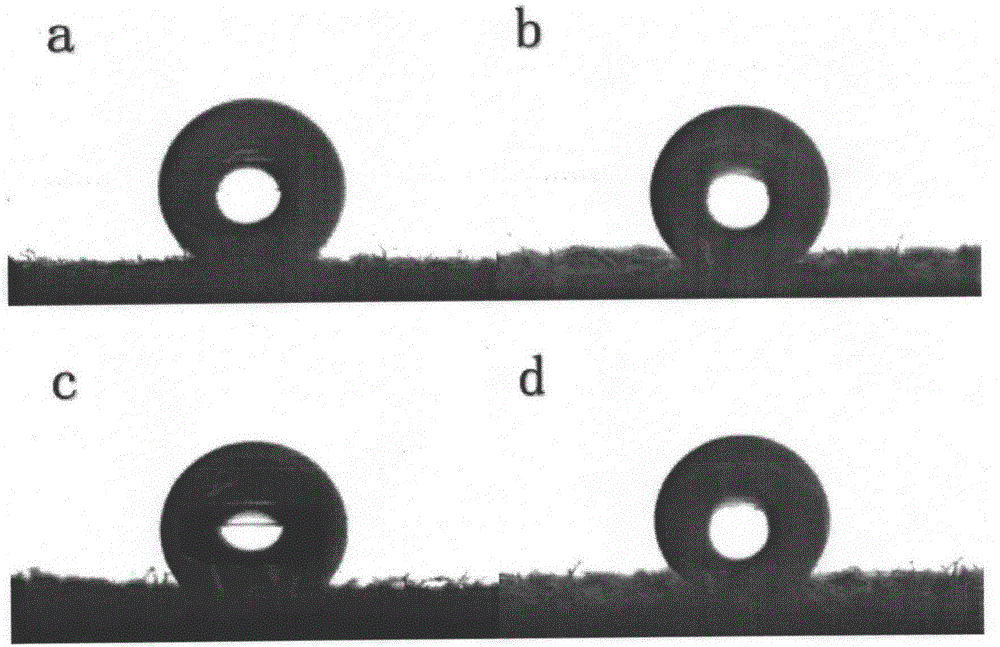Ultraviolet curing reaction-based fluoride-free and water-repellent finishing method of cotton fabric
A fluorine-free water-repellent and curing reaction technology, applied in the directions of physical treatment, fiber treatment, plant fiber, etc., can solve the problems of poor fastness of the finishing agent, not resistant to washing, expensive fluorine-containing mercaptans, etc. The effect of high washing fastness and obvious water repellent effect
- Summary
- Abstract
- Description
- Claims
- Application Information
AI Technical Summary
Problems solved by technology
Method used
Image
Examples
Embodiment 1
[0036] Use 3-mercaptopropyltriethoxysilane to modify the cotton fabric, and react with vinyl POSS and mercaptosilane to make the cotton have good water repellency. The specific steps are:
[0037] (1) Pre-processing stage:
[0038] ① Prepare 15g / L sodium hydroxide and 7g / L Pingping O solution, and roughen the cotton fabric for 20 minutes at 70°C;
[0039] ② Prepare a 5wt% 3-mercaptopropyltriethoxysilane ethyl acetate solution, put the roughened cotton fabric into the solution, seal the beaker mouth with a film, place it in a constant temperature magnetic stirring water bath, and shake it at 25°C for 2 hours ;
[0040] ③Take out the cotton fabric, wash it thoroughly in distilled water, and dry it under vacuum at 60°C;
[0041] (2) Finishing stage:
[0042] ① Prepare vinyl POSS and 3-mercaptopropyltriethoxysilane dichloromethane solutions with a mass concentration of 1%, fully ultrasonically oscillate, and then add 2,2-dimethoxy-2-phenylacetophenone Photoinitiator, ultrasoni...
Embodiment 2
[0047] Use 3-mercaptopropyltriethoxysilane to modify the cotton fabric, and react with vinyl POSS and alkyl mercaptan to make the cotton have good water repellency. The specific steps are:
[0048] (1) Pre-processing stage:
[0049] ① Prepare 15g / L sodium hydroxide and 7g / L Pingping O solution, and roughen the cotton fabric for 20 minutes at 70°C;
[0050] ② Prepare a 5wt% 3-mercaptopropyltriethoxysilane ethyl acetate solution, put the roughened cotton fabric into the solution, seal the beaker mouth with a film, place it in a constant temperature magnetic stirring water bath, and shake it at 25°C for 2 hours ;
[0051] ③Take out the cotton fabric, wash it thoroughly in distilled water, and dry it under vacuum at 60°C;
[0052] (2) Finishing stage:
[0053] ① Prepare a dichloromethane solution of vinyl POSS and dodecanethiol with a mass concentration of 1%, fully ultrasonically oscillate, then add 2,2-dimethoxy-2-phenylacetophenone photoinitiator, and ultrasonically Shock; ...
Embodiment 3
[0058] Use 3-mercaptopropyltriethoxysilane to modify polyester-cotton fabric (65 / 35), and react with vinyl POSS and alkyl mercaptan to make polyester-cotton have good water repellency. The specific steps for:
[0059] (1) Pre-processing stage:
[0060] ①Prepare 15g / L sodium hydroxide and 7g / L PingPingO solution, roughen the polyester-cotton fabric for 20min at 70°C;
[0061] ② Prepare a 5wt% 3-mercaptopropyltriethoxysilane ethyl acetate solution, put the roughened polyester-cotton fabric into the solution, seal the beaker with a film, place it in a constant temperature magnetic stirring water bath, and shake it at 25°C for 2 Hour;
[0062] ③Take out the polyester-cotton fabric, wash it thoroughly in distilled water, and dry it under vacuum at 60°C;
[0063] (2) Finishing stage:
[0064] ① Prepare a dichloromethane solution of vinyl POSS and dodecanethiol with a mass concentration of 1%, fully ultrasonically oscillate, then add 2,2-dimethoxy-2-phenylacetophenone photoinitia...
PUM
| Property | Measurement | Unit |
|---|---|---|
| critical surface tension | aaaaa | aaaaa |
Abstract
Description
Claims
Application Information
 Login to View More
Login to View More - R&D
- Intellectual Property
- Life Sciences
- Materials
- Tech Scout
- Unparalleled Data Quality
- Higher Quality Content
- 60% Fewer Hallucinations
Browse by: Latest US Patents, China's latest patents, Technical Efficacy Thesaurus, Application Domain, Technology Topic, Popular Technical Reports.
© 2025 PatSnap. All rights reserved.Legal|Privacy policy|Modern Slavery Act Transparency Statement|Sitemap|About US| Contact US: help@patsnap.com



